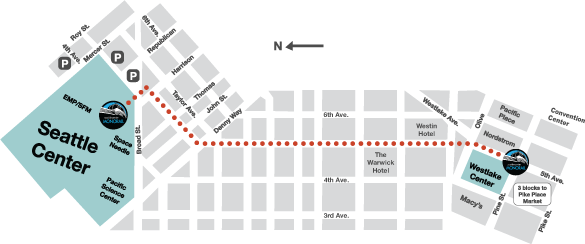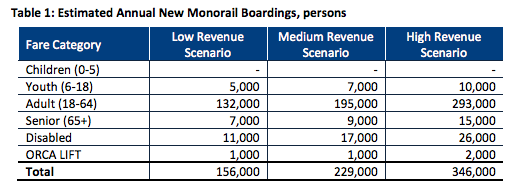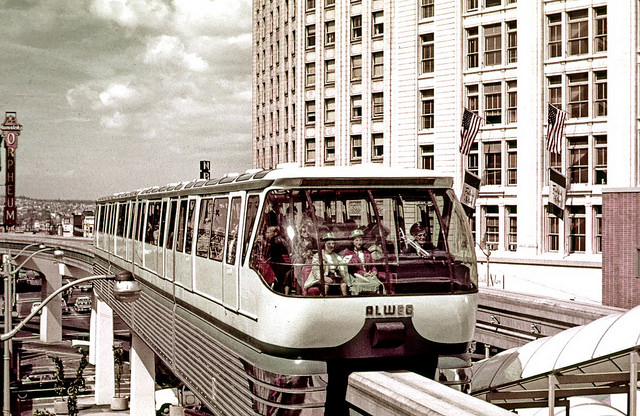On Thursday, Seattle Mayor Ed Murray released a statement in support of integrating the Seattle Monorail into the ORCA fare payment system. This could be a boon for ridership, long-term financial solvency, and improved customer experience.
In his press release, Mayor Murray highlighted the fact that the monorail is a true public transportation service connecting major districts of the city. “Seattle Center is becoming more connected to downtown, and the Monorail is the best path between these two important hubs,” Mayor Murray said. “Creating a seamless transit network that ultimately sweeps across downtown will connect Queen Anne to South Seattle, the University of Washington to the Gates Foundation, KeyArena to SeaTac. The Monorail may have been built in a different era, but it plays a vital role for connecting Seattle Center to today’s regional transportation network.”

The Seattle Monorail was originally opened in 1962 as a demonstration project for the World’s Fair. It spurred more than a generation of interest in the futuristic technology and even a series of city-wide initiatives to build a full network of monorail lines, each ultimately failing. The 0.96-mile long line offers a non-stop ride between Westlake Station and Seattle Center making it ideal for some Downtown and Uptown residents, workers, and visitors. However, the fare structure leaves it out of the local public transportation network forcing riders to purchase separate tickets and passes.
Ticketing on the monorail is generally by paper at the monorail stations. Fares are currently $2.25 one-way for adults and $1.00 for youth and individuals who qualify for reduced fares (e.g., disabled, seniors, and Medicare cardholders). Regular riders, however, can purchase a monthly pass for unlimited rides, which are sold at ticketing booths and online. The cost of the pass is $45 for adults and $20 for youth and reduced fare recipients. Monthly passholders can use a mobile app, Hopthru, to avoid the hassle of carrying around another pass in their pocket.
A year-long study by the Seattle Department of Transportation (SDOT) suggests that the monorail could be a good fit for the ORCA pass network. The ORCA pass is used by nearly all local public transit agencies, including King County Metro Transit, King County Ferries, Sound Transit, Seattle Streetcar, and Washington State Ferries. Integration would mean that ORCA passholders could make free transfers from connecting buses and light rail without having to pay a separate fare (except whatever cost differential there may be for the maximum trip fare). In fact under the typical ORCA fare structure, a roundtrip on the same service within two hours would not result in another fare payment for OCRA passholders making it effectively free.
There are challenges to the integration. One of those is harmonizing the structure of fares. The ORCA fare structure has different fare categories than the monorail. The biggest differences are discounts for large groups on the monorail and the ORCA Lift reduced fare program. The other difference generally are based on age for fare categories, but the age differences are not that great:

By integrating with ORCA, the study suggests that ridership would grow by 156,000 to 346,000 annual rides. The baseline ridership for 2014 was 2,147,800. So on the low revenue growth scenario, there could be a 7% ridership increase while the high revenue growth scenario suggests a 16% ridership increase during the first three years.

The low revenue growth scenario assumes that a big share of riders convert to ORCA usage from cash fares while tourist-oriented monorail riders-who almost universally pay cash fares–grow very little. Meanwhile, the high revenue growth scenario assumes that only a small portion of cash fare payment trips convert to ORCA and that a large share of new rides are created by the incentives of the ORCA payment option.
The initial phase of ORCA integration could be somewhat costly to the Seattle Monorail, especially in the lower revenue growth scenarios, but the study suggests that going to ORCA could eventually keep the monorail in the black.
The study highlights a few reason why revenues during initial ORCA option are likely to fall into the negative column:
- “Changes to existing monorail fare categories, which would need to be realigned to match those used by other transit agencies. The updated categories would include a larger range of ages in both the children and youth fare categories.”
- “Shifts from cash to ORCA for existing riders. Revenue per boarding would be lower due to acceptance of transfers and passes.”
- “Costs related to being an ORCA affiliate, including ORCA participation fee and contribution toward regionally-shared costs. Note that this report does not include other potential one-time or annual fees.”
- “Fare revenue received from riders who pay with the ORCA Business Passport product is phased in during the initial 16 months of ORCA acceptance.”
Fares on the monorail are set to rise 25 cents in October. Another 25-cent increase is recommended to facilitate ORCA integration costs. Top fares could eventually be $2.75, which would mirror the King County proposal to set county-wide adult bus fares on King Count Metro Transit at a flat $2.75. Tourists and local riders alike, however, would still be able to pay cash fares at monorail stations.
ORCA integration would be a huge step toward making the Seattle Monorail a true piece of Seattle’s transit network. It’s especially likely that the service could become a greater part of the Uptown-Downtown transit network as redevelopment takes shape in Uptown near SR-99 and points north and east of Seattle Center. That, however, partially hinges on some version of the Uptown rezones and urban design framework being adopted. Monorail ridership could also get a boost if plans to upgrade Seattle Center Coliseum (a.k.a KeyArena) move forward and succeed in attracting more professional sports teams and concerts. The winning proposal included money for Monorail upgrades intended to allow doubled ridership and highlighted ORCA integration in its transportation plan.
Title image courtesy of the Seattle Municipal Archive.
City Hall Advances Seattle Center Arena And Lander Overpass Plans
Stephen is a professional urban planner in Puget Sound with a passion for sustainable, livable, and diverse cities. He is especially interested in how policies, regulations, and programs can promote positive outcomes for communities. With stints in great cities like Bellingham and Cork, Stephen currently lives in Seattle. He primarily covers land use and transportation issues and has been with The Urbanist since 2014.




